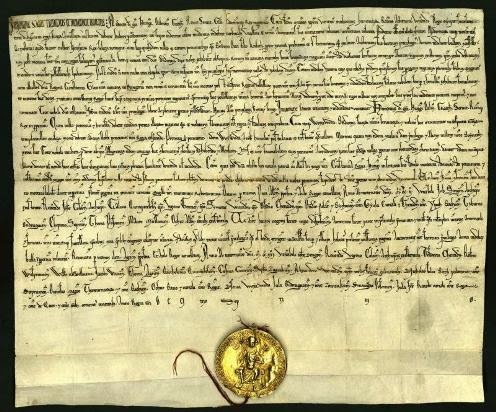Perhaps there is no Hungarian-minded person in the world who does not know the year 1222 and the concept associated with it, the Golden Bull
It is exactly 800 years since World War II. King András (1205–1235) issued the Golden Bull, the certificate with pure gold seals, which is still considered a powerful symbol of the Hungarian rule of law.
Our Basic Law, adopted in 2011, much debated by the West, regards the Golden Bull as a historical precedent, which, together with the Holy Crown, embodies the constitutional continuity of the Hungarian State and the unity of the nation. One can laugh at such avarice for those for whom the past is narrowed down to their own sphere of interest and knowledge, for those who do not know their history, and therefore find Hungarians who constantly refer to their national past to be ridiculous.
However, the Holy Crown is not merely a coronation insignia placed on the king's head, but according to the Hungarian legal concept, it is a symbol of Hungarian statehood, which, regardless of the person of the king, embodies the country's territorial unity and its inhabitants. Even today, the Holy Crown, which originated from the first king, Saint Stephen (1000–1038), is not a museum object, so it is kept in the Parliament building, the place of the legislative session. Our historical constitution, the Golden Bull, the greatest achievement of Hungarian constitutional development, plays a similar role to the Holy Crown. In Europe, it is preceded in time only by the Magna Charta Libertatum of 1215, the English charter of freedom guaranteeing religious rights, but there is little evidence of a connection or influence in the content of the two charters.
The Golden Bull was not forced out of the king by a rebellion, because the king's power, wealth and authority were undisputed. He was the country's largest landowner, his income was outstanding even in international comparisons, and his diplomatic and dynastic relations were good. His father, III. Béla (1173–1196) was once an expectant to the Byzantine imperial throne, and had significant Eastern kinship on his mother's side. He himself married Princess Gertrud of Meran, his son-in-law was the Margrave of Thuringia. András's daughter is Saint Elizabeth of Árpád-háza, whom the Germans refer to as Elisabeth von Thüringen as their most beloved saint. (Just like that, parenthetically, the Germans were speechless at the dowry of the Hungarian princess, because they had never seen such wealth in their lives.)
The medieval Kingdom of Hungary was considered the language of the balance in the power competition between the Byzantine Empire and the German-Roman Empire. It could not be circumvented, and it was not at the mercy of the pope either, since the appointment of ecclesiastical dignitaries belonged to the king, to which the pope could only nod. The country was in external and internal security, II. András's great predecessors, the Hungarian kings of the Árpád House, built the buffer zones that ensured the protection of the country, using today's terminology. The areas to the south all belonged to the Hungarian sphere of interest, the Hungarian king - let's taste it! - By the grace of God, he is also the king of Dalmatia, Croatia, Rama (Bosnia), Serbia, Galicia and Lodomeria (Volodimir) for eternal memory, at least in the bearing of the titles until 1918.
II. András was a worldly man, in 1217 he led an international crusader army of more than five thousand men to the Holy Land, which shows the reputation of the Hungarian kingdom. The media of the time classified the campaign as unsuccessful, even though it was really successful: it was an exceptionally well-led, order-making, peace-making mission, and András did a great service to Europe with it. With his diplomatic acumen, he also forged advantages for himself and established dynastic relations with the Christian rulers of the East. He undertook the "perpetual maintenance" of Margat castle in present-day Syria. (Perhaps that is why Hungarian archaeologists are working on the current excavation of the castle.)
Returning from the campaign with experience II. András wanted to put the royal power on a new foundation. He saw that the country's economic structure was lagging behind, that a new arrangement was needed, as well as a narrowing of the rights of the Spanish states. His administrative reforms covering many areas - like all innovations - brought benefits to some (royal servants) and harm to others (várispans). Those who were the beneficiaries of the old system naturally resisted those to whom it brought benefits, but they could represent the social base of the king's new system. The Marxian thesis about antagonistic class societies was not typical for Hungarian conditions at the time, the society consisted of freedmen and serfs, stratified. The king offered the "system of national cooperation" to the church, nobles and all free people, including royal servants with land and castle serfs.
The Golden Bull, consisting of thirty-one articles, is a confirmation and guarantee of the king's reform policy, as well as a summary of rights and duties. The individual articles are the cornerstones of the legislation, which are still in effect today, and define fundamental, modern rights such as the individual's right to freedom, personal and material security, respect for private property, national defense obligations, taxation and legislation, the regulation of the administration of justice, and even the (royal) the right to resist authority.
The right to resist is a thousand-year-old right in Hungary, it has been part of the Hungarian legal system since the founding of the state, and although it is considered outdated in Western Europe, the current Hungarian Basic Law includes the right to resist attempts to seize power by force. It doesn't hurt if they also know in Brussels that the Hungarian administrative system based on counties already existed in 1009, and that the county self-government with the right to judge would have eight hundred years of tradition if the communists had not abolished it with the stroke of a pen in 1950.
Those attacking Hungary would also do well to know that the Golden Bull ensured the freedom derived from St. Stephen to foreigners as well as to Hungarians, wherever they came from. That someone could only be convicted if they were found guilty according to the law, and that there was a right of appeal, that the king ensured that the nobles were exempt from taxes, for which they paid - exclusively for the defense of the country - with their "blood", i.e. with military service. The king "left no one by the wayside", he even guaranteed the financial and personal security of servants, widows and orphans.
The Golden Bull II. András destined it for eternity. It was renewed countless times, its contents were confirmed at every coronation from 1351, the kings had to swear allegiance to it, and it was considered the primary source of law until 1848, when the civil constitution was created. The Golden Bull is the starting point of the law-abiding Hungarian sense of identity. The Hungarians, who were considered rebels, never rebelled against their kings, they never used the right to resist during the centuries, and at one time they even renounced it for the sake of the country. But they insisted on it, on law, which protects against injustice.
(The author is a historian)
Our opening picture shows the Golden Bull. Source: Parliamentary Museum













